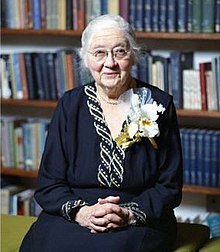| Mildred Allen | |
|---|---|
 | |
| Born | (1894-03-25)March 25, 1894 Sharon, Massachusetts |
| Died | November 4, 1990(1990-11-04) (aged 96) Holyoke, Massachusetts |
| Nationality | American |
| Alma mater | Vassar College, Clark University |
| Scientific career | |
| Fields | Physics |
| Institutions | Mount Holyoke College |
| Thesis | On thermal emission and evaporation from water (1922) |
| Doctoral advisor | Arthur Gordon Webster |
Mildred Allen (March 25, 1894 – November 4, 1990) was an American physicist.
Biography
Early life and education
Mildred Allen was born in Sharon, Massachusetts to MIT professor C. Frank Allen and Caroline Hadley Allen. She had one younger sister, Margaret Allen Anderson.
Allen graduated from Vassar College in 1916 with Phi Beta Kappa honors. She completed her doctoral studies in physics in 1922 at Clark University with Arthur Gordon Webster, with thesis research done at Massachusetts Institute of Technology.
Career
During the 1920s and early 1930s, Allen taught at Mount Holyoke, Wellesley and Oberlin Colleges and undertook post-doctoral work at the University of Chicago and at Yale University. She began working with William Francis Gray Swann at Yale and continued work under his direction with the Bartol Research Foundation between 1927 and 1930. She also did research at Harvard University before becoming a professor at Mount Holyoke, where she taught for 31 years, until her retirement in 1959.
For nearly 20 years, starting in the early 1960s, Allen collaborated with Erwin Saxl, an industrial physicist living in Harvard, Massachusetts, on experiments with a torsion pendulum. Allen and Saxl reported anomalous changes in the period of a torsion pendulum during a solar eclipse in 1970 and hypothesized that “gravitational theory needs to be modified”. Their measurements, and similar anomalies earlier observed by Allais using a paraconical pendulum, have not been accepted by the physics community as in need of unconventional explanation, and subsequent experiments have not succeeded in reproducing the results.
References
- "Mildred Allen, 96, Taught at Mount Holyoke". Boston Globe. 1990-11-16. NewsBank ID 0EADDF1742E1FD07.
- Saxl, Erwin J.; Allen, Mildred (1971), "1970 Solar Eclipse as "Seen" by a Torsion Pendulum", Physical Review D, 3 (4): 823–825, Bibcode:1971PhRvD...3..823S, doi:10.1103/PhysRevD.3.823
- Schilling, Govert (27 November 2004), "Shadow over gravity", New Scientist, 184: 28–31
- Van Flandern, T.; Yang, X. S. (2003), "Allais gravity and pendulum effects during solar eclipses explained", Physical Review D, 67 (2): 022002, Bibcode:2003PhRvD..67b2002V, doi:10.1103/PhysRevD.67.022002
External links
- Interview of Mildred Allen by Katherine Sopka, College Park, MD USA: Niels Bohr Library & Archives, American Institute of Physics, June 18, 1979
- Mildred Allen papers at Mount Holyoke College
- Mildred Allen photo Archived 2011-10-03 at the Wayback Machine dated 1959, Mount Holyoke Digital Collections Online
- Mildred Allen at the Mathematics Genealogy Project.
- 1894 births
- 1990 deaths
- Clark University alumni
- Wellesley College faculty
- Oberlin College faculty
- Yale University alumni
- University of Chicago alumni
- Massachusetts Institute of Technology people
- Mount Holyoke College faculty
- Vassar College alumni
- Harvard University people
- American women physicists
- People from Sharon, Massachusetts
- 20th-century American women scientists
- 20th-century American physicists
- Fellows of the American Physical Society
- 20th-century American women academics
- 20th-century American academics